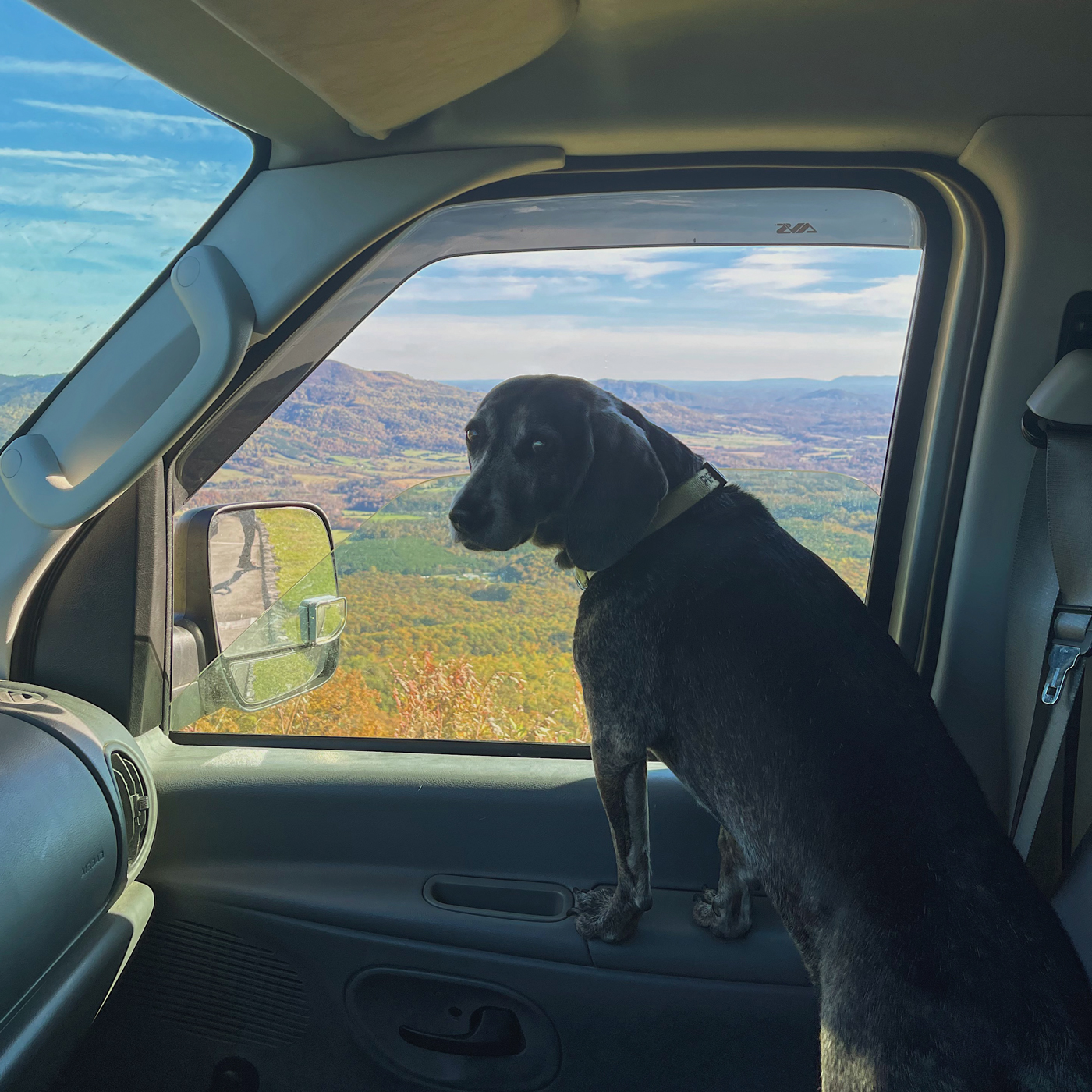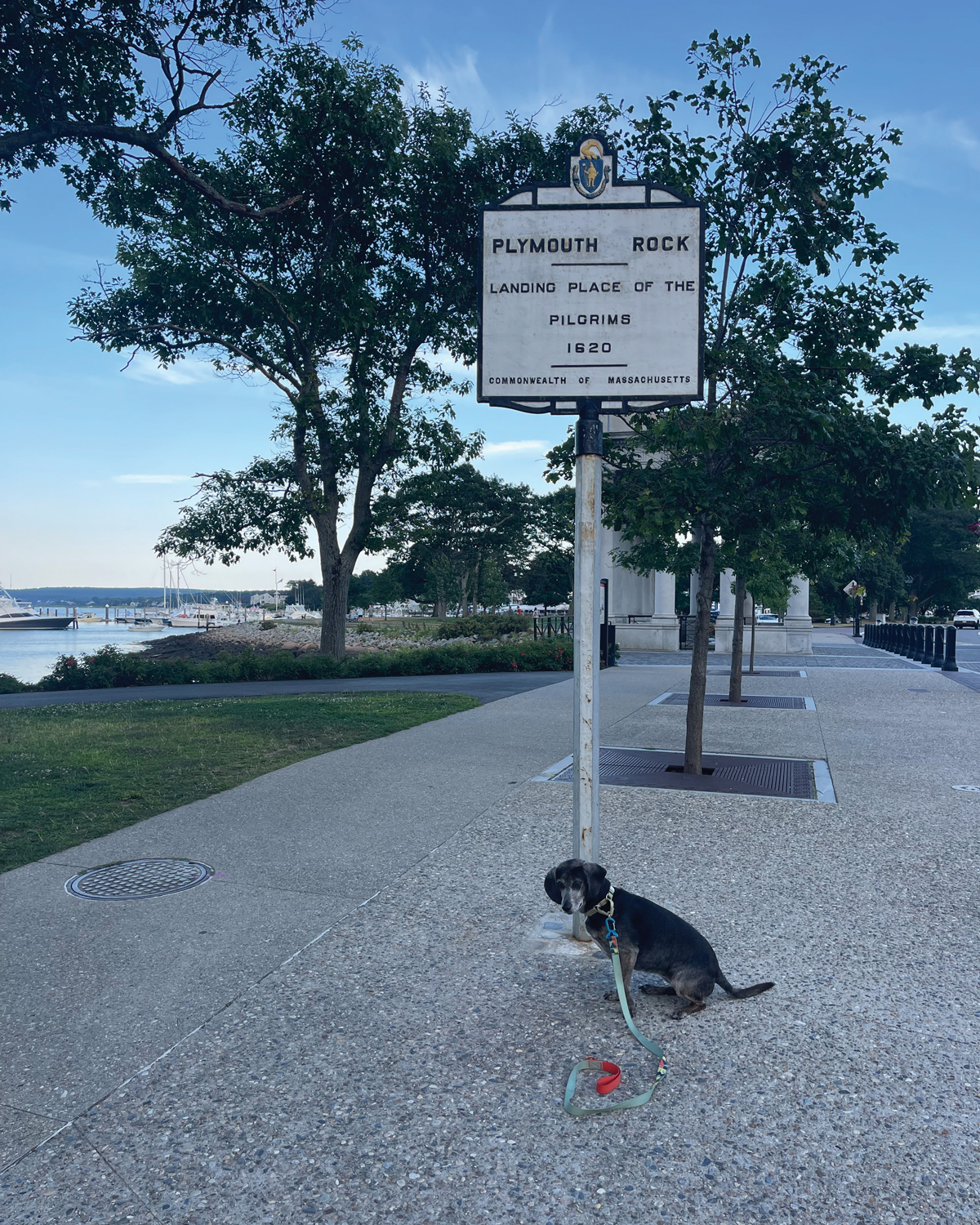Eleven-year-old Piper has visited 13 states and driven through at least three or four more. She’s called five states “home” for at least a couple of months or more. Not bad for a runty kid from nowhere North Carolina. Of course, by a kid, I mean a dog. But as a millennial, those two words are nearly synonymous.

Outdoor landmarks are great destinations to visit when traveling with pets. Here, Piper poses in front of the Pemaquid Point Lighthouse in Maine.
Piper, a 30-pound brown-and-black hound mix, came into my life just before graduating from college in 2013. From the start, I enjoyed bringing Piper with me wherever I went. But our relationship blossomed in 2020, when I bought and converted a cargo van into a home on wheels. Since then, the two of us have traveled up and down the East Coast. Along the way, I’ve learned a thing or two about traveling and sharing adventures with your pet.
Road-tripping With Your Pet
The most convenient way to travel with your pet is in your own car.
Imagine a road trip with your best friend – indulgent snacks, throwback music and the excitement of an unknown destination ahead. This assumes your dog is your best friend. If this isn’t the case, this article might not be for you.

Road trips are about slowing down; the Blue Ridge Parkway offered the right pace and beautiful views through southwestern Virginia.
I got lucky with Piper. She’s a natural-born co-pilot, happy to sleep through hours of highway miles. But I’ve traveled with dogs that are not comfortable in a moving car; they pant and whine and occasionally vomit. Sometimes they try to climb onto your lap for comfort. This kind of behavior is dangerous for you, the driver, and it’s not an ideal way to introduce travel to your pet.
If you know your dog is an anxious traveler, consider some form of containment to keep them from encroaching on your personal space while driving. Several companies make travel-ready pet crates or carriers for cars and other types of safety restraints. Personal preference and pet behavior should inform the decision to crate or restrain a dog in a car.
You might also consider talking with your veterinarian about anxiety or anti-vomit medications for your pet before traveling. However you choose to have your pet in your vehicle while traveling, their safety and your own are improved by keeping them calm and comfortable. That includes when the car is parked.
Managing the Temperature in Your Car
Sometimes, there’s no way to avoid leaving your pet in a parked car for a time. As a solo traveler, it’s impossible.
It’s a divisive topic, but often a reality when traveling with your dog. For your pet’s comfort, and the ease of mind of strangers nearby, I have a few ways to keep your car cooler and your pet comfortable.

The white beaches of Siesta Key aren’t dog-friendly, but neighboring Sarasota, Florida, offered plenty of places – including Bayfront Park & Marina – to explore with Piper.
Blocking the sun from entering the vehicle through windows is essential. If there is a shady spot in the parking lot, that’s where I’m heading. Even if it’s the farthest space from the store entrance or across the street in a neighboring parking lot. I also try to plan my trips to the grocery store or other errands in the morning or evening, when the temperature is cooler.
Insulated window shades go a long way in keeping your car cool, too. Sites like Amazon and retailers like WeatherTech offer sun protection for just about every vehicle. Mesh window screens also help manage the temperature by allowing you to leave your windows cracked or partway down without letting your pet escape or curious hands reach in for a head scratch.
Mass and Public Transit with Pets
Other forms of transportation can be dog-friendly, depending on the size and breed of your dog.
I don’t have much experience with pets and mass transit, but I do some research every time I want to take Piper on a non-van trip. Most airplane and train companies impose restrictions on traveling with pets, such as a weight or breed restriction or verification of medical records. Unfortunately, bus companies rarely permit pets onboard. (Note: Such restrictions don’t apply to service dogs.)
The advice for mass and public transit is the same as finding lodging for you and your pet: always call ahead (or visit websites) to ensure you know the current policies. For example, Metro in Washington, D.C., allows pets to travel on the subway and buses as long as they are confined in carriers. (Well, that excludes Piper!)
Aside from the rules and regulations surrounding pets in mass transit, your pet’s comfort level with public spaces, crowds and noise should be considered before traveling. Seeing your dog stressed increases your own cortisol levels, which makes every little thing that much tougher to navigate together. Common signs of stress in dogs include panting, excessive yawning, pacing and whining.
Booking Pet-friendly Accommodations
Of course, vacation isn’t all travel. There’s the destination part, too!
I have a personal bias for green destinations – mountains and forests with plenty of free camping opportunities under tall shade trees. But Piper and I have managed to travel and stay comfortably in both remote campgrounds and big cities.
Many campgrounds and hotels will require proof of a rabies vaccination or other medical records to show your pet is in good health. They may also charge a pet fee or deposit. And, I can’t say this enough: when in doubt, always call ahead to confirm pets are permitted.

One of those meant-to-be moments occurred when I was invited to a conference at a dog-friendly hotel in Historic Williamsburg, Virginia.
For the comfort and safety of their staff, hotels will ask you to either crate your pet when you’re away from your hotel room or require you never to leave your pet alone in your hotel room. Have a plan for managing the activities of your vacation and your pet’s needs.
If your dog has never been camping before – especially tent camping – test out their comfort in the backyard or at a nearby park before committing to a destination. Unlike the walls of your home, tent fabric does little to muffle outside noises and smells that may interest or frustrate your pet and interrupt your sleep.
Staying in an unfamiliar space may cause a heightened sense of alertness in some dogs. I learned quickly that Piper was calmer when I brought a blanket or dog bed from home. Having something that smells like home and is familiar to your dog can help them feel comfortable in a new space. Likewise, to limit sound sensitivity, I often leave the TV on or pack a small FM radio to play music while I’m away, which helps muffle outside noises that may cause Piper to bark.
Adventure Safely with your Pet
The best way to plan a fun, safe adventure with your pet is to know your pet well.
Consider their usual energy level and exercise habits – are they ready for a week of hiking or would they prefer five days of relaxing next to a pool? Is your pet used to doing their business on a sidewalk or do they need abundant green space to run around first? Are they better suited to winter wonderlands or more temperate climates?

One of our favorite hikes in the Adirondack High Peaks Region takes us to Hopkins Mountain in Keene Valley, New York.
Set up your pet for success on your vacation by getting them comfortable with the sights, sounds and smells of your destination environment before leaving home. You can test their comfort levels by taking them for a walk in an urban environment, asking them to sit with you outside at a busy park or visiting stores that allow pets to see how they behave. As a hound owner, I’ve found success using treats as a positive reinforcement when introducing new environments and travel situations.
Most dogs I’ve traveled with are surprisingly adjustable. Piper enjoys the smells and abundant hands for free head scratches found in cities and small towns, while also eagerly bounding up backcountry trails for a quiet day in the woods. But she’s not as young as she used to be, so I’m careful to limit her activity to what she can handle while building in “rest days” between hiking adventures.
Be willing to adjust your vacation plans if your dog isn’t taking to the original plan how you thought it might. Part of the adventure is learning more about your dog and finding ways to make the trip fun for both of you.
When we’re in cities – most recently, we visited Washington, D.C., in April – part of the adventure is exploring the city by foot. It’s an activity that is well suited for dogs. Piper got to smell everything that happened on those streets in the last 48 hours, while I got to visit the childhood home of Duke Ellington. I often use Google Maps satellites to look for green spaces and parks where Piper can do her business on real grass like she’s used to.

Piper found Plymouth Rock less interesting than Plymouth geese on our day spent in the historic town.
Regardless of how many miles Piper and I walk or hike on road trips, her eating habits change when we’re on the road compared to at home. Even a veteran traveler like Piper experiences travel stress and may refuse to eat on the first day of our journey. It’s typical for pets to alter their eating habits when traveling. I supplement with a few dinner scraps and some of her favorite treats. I suggest using leak-proof Tupperware containers as your dog’s food and water bowls while traveling.
Building a vacation around your pet can be a fun way to explore and build a deeper bond. Dog-friendly vacations may look different from your usual beach adventure or road trip, but the memories you’ll create together make a few small compromises worth the effort. With your dog’s comfort and safety top of your mind and some pre-planning, you and your dog can have the time of your lives anywhere your adventure takes you.






SHARE
PRINT